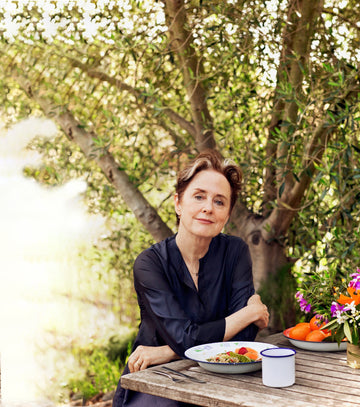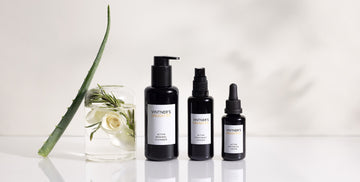In Conversation With Alice Waters
Our founder talks to this inspiring iconoclast about activating the senses, finding beauty in simplicity, and turning vision into reality.
To say I am inspired by Alice Waters would be a huge understatement. Growing up, I was lucky enough to have friends of the family who were part of her social circle, and I was riveted by their stories about what was happening across the Bay Area. With Chez Panisse, the iconic restaurant she opened in Berkeley, California nearly five decades ago, Alice Waters forever transformed the way we eat. Her unwavering devotion to sourcing locally and eating seasonally, and the extraordinary dishes that resulted, shifted the cultural conversation around how we value and honor the connection between food and our bodies. She showed us how to reflect on the beauty of a thoughtfully grown, organic tomato, and enjoy it simply and fully. She showed us the importance of recognizing the farmers who devote their lives to growing the food we eat and serve as responsible stewards of the land. In extending her revolutionary vision to children with The Edible Schoolyard Project, she brought the beauty of simple pleasures and sensory education into public schools, inspiring so many, including former first lady Michelle Obama.
Alice and I spoke shortly after California’s shelter-at-home order went into effect, and as Chez Panisse, like so many other restaurants, was finding its way forward. You can learn more about how to support them here. My time talking to Alice was really, as I said to her, “like going to church,” and I hope you enjoy our conversation as much as I did.
xxApril
Oh Alice, thank you so much for taking this time with us. I am so incredibly appreciative.
My pleasure.
Did you ever think when you opened Chez Panisse in 1971 that it would have the cultural influence it has had?
I had no idea. I was just opening the restaurant basically for my friends. Instead of coming to my house and eating for free, I figured that they might come to the restaurant and pay. So that’s how it began, as innocently as that. I wanted to share the experiences that I had had in France. Really that we had all had, reading our Elizabeth David cookbooks. We believed that we could cook simply and make that whole meal just one menu a day. We introduced people to taste.
We believed that we could cook simply and make that whole meal just one menu a day. We introduced people to taste.
When did you first realize you were having this incredible influence? Was there a moment when that became clear to you?
I’d say maybe the moment was when Marion Cunningham brought James Beard to Chez Panisse. And James Beard said, “This is not a restaurant. It’s like eating in someone’s home.” He wrote about us not long after that, and that just opened up a whole world of readers and a whole world of potential customers.
Did you all of a sudden have people lining up outside the door?
It wasn’t quite like that, but it definitely put the word out to other magazines. Gourmet magazine came knocking on our door. Craig Claiborne wrote about us for The New York Times. But it really happened for us when we were looking for ingredients, and we ended up at the doorsteps of the local organic producers. Then we started putting them on the menu, because people wanted to know, and would ask, “When are Mas Masumoto’s peaches coming?” That really had a very big influence when we opened the Café in 1980.
Were you the first restaurant to put the names of the producers on the menu?
Well, undoubtedly there were some people someplace who were doing that, but I think we were the first to celebrate in that way a particular producer. To say that this is made with Bob Cannard’s salad, or somebody’s very particular apricots, I think that was kind of a natural next step. I really got the message that the restaurant was only as good as the taste of food, and the real taste and nourishment of the food came from the people that were taking care of the land in that organic, regenerative way.
We began a big change for the restaurant when we decided to only eat seasonally and locally, which happened in the early 80s. We thought it was local enough to get salmon from Alaska, but it turned out that when we did that, it meant that we didn’t appreciate what came from Bodega Bay, right here next to Berkeley. So we stopped buying it, and waited for that absolutely irresistible salmon, and could then give the money directly to the fishermen or to the people who were growing the food, and that made the biggest difference of all. We paid the real cost, directly, no middle-man. Now they tell us what to cook by giving us the vegetables. That relationship has really changed not only the restaurant, but it is the driving force for me around school lunch. If we could use buying power as the engine for regenerative agriculture in this country through the public school system it would be amazing.
I really got the message that the restaurant was only as good as the taste of food, and the real taste and nourishment of the food came from the people that were taking care of the land in that organic, regenerative way.
That was actually my next question. Where did the inspiration for the Foundation and The Edible Schoolyard come from? It’s an incredibly audacious idea. How did it take shape and go from you thinking it was a good idea to actually making it happen?
I have a child, and I wondered where she would go to school, and what she would eat at school. That led me to investigating the public school system in Berkeley, California, and I realized that something had happened since I first came to Berkeley in 1964. Back in 1983, when my daughter was born, I was very public about the industrialization of the schools, like the industrialization of the farms, and how things had fallen apart so completely. It looked like the school near my house was abandoned—there was graffiti everywhere and weeds on the lawn. It used to be a school that had 500 students and now it had 1,000 middle school kids. The principal reached out to me and said, ‘Can you help?’ I went over to that school, Martin Luther King Jr. Middle School, which had a population with families that spoke 22 different languages at home, and I really thought about it, Montessori teacher that I was. I looked around the school with the principal and I had the whole vision. I said, ‘We could make a garden classroom.’ Not to teach gardening per se, but to teach math. To teach science. To teach art. I said, ‘We could make this bungalow into a kitchen. We could have a kitchen classroom.’ Not to teach cooking per se, but to teach math.
Incredible. Did that all come to you as a complete vision when you were there?
Yes, it just came to me as a complete vision. I imagined a meal out there in the yard and a cafeteria that feeds all the students seated at the table. I imagined that school lunch could be part of academia. What if you were studying history, and you went into the cafeteria and you could eat the food of the Arabian Peninsula that you had just been talking about in class? You could have tabbouleh salad, a spicy carrot soup and pita bread as an extension of your class that allowed you to experience the geography of that place. I told the principal all of this, and he was a little bit overwhelmed, and I didn’t hear from him for 6 months, and I was so relieved. So relieved. Then I got a call from him and I went over to the school, and he said, ‘Alice, I think we’re ready to do the garden.’ And I said, ‘Neil, it’s all or nothing.’ And he said, ‘I think you’ll frighten people when you talk about a free, organic school lunch.’ And I said, ‘But Neil, that’s all part of the big picture.’ And he said to me, ‘Alice, I promise you. I believe in it and we will make that happen. But let’s just focus on the garden classroom and the kitchen classroom.’ That was 25 years ago, and I’m extraordinarily happy to report that the kitchen and the garden classrooms have really inspired a network of people around the world who are doing something in that vein.
Including Michelle Obama. Your work at the White House with Michelle Obama and extending The Edible Schoolyard to the nation level must have been a huge moment.
Well, it was. She had those values and her inspiration to do the garden was amazing, and I know that she believed in what we were doing at the school. But she did it so beautifully, and she had Sam Kass, who was a great cook and gardener who helped her implement that project. We have a network of nearly 7,000 schools now, that are around the world, and almost 700 that are here in the state of California. Some of them were started by restaurateurs, like Suzanne Goin in Los Angeles. We had six original projects, and after about a year we realized they all had their own ways of doing it, but they all believed in the same values of stewardship, sustainability, nourishment and community. It proved that it doesn’t matter where it is on the planet really—there’s a way to teach interactively, feed children sustainable, regenerative food, and engage them and the community around them in building a network of support. I know it will work. We’re beginning to build that network, like we have at Chez Panisse, but on a grand scale.
I imagined a meal out there in the yard and a cafeteria that feeds all the students seated at the table. I imagined that school lunch could be part of academia.
That's extraordinary and congratulations. Congratulations also on the upcoming 50th anniversary of Chez Panisse. No restaurant does that. It is about having a vision, following your vision and never veering, and bringing people along with you.
We want to have an incredible event in the fall of 2021, which will be the 50th year of Chez Panisse, and connect the dots for everybody between food, agriculture, and climate. We plan to make a table from the capitol in Sacramento, all the way down to the Sacramento River, easily a mile away, and honor the farmers and the teachers who feed us and who nourish us. We’re going to try and get every single cook we know to cook for us.
I can just see it in my head. That is extraordinary, and what a way to honor your 50th anniversary.
Well, we’re getting a test right now of what climate change is going to ask of us, and we need to respond. We’re going to revive the victory gardens of the past, we’re going to grow our own food, we’re going to treasure the people that grow locally and feed us. It’s what can repair our immune systems and address climate at the same time. What more helpful scenario do we need?
We’re getting a test right now of what climate change is going to ask of us, and we need to respond.
Exactly. It’s an extraordinary time we’re all living through and I hope we learn from it.
I really do too. We’re learning the hard way. We need to be educated, not just to make money, but to learn how to care for ourselves and our communities. We need to be taught the values that we need for our future, and we need to fall in love with our children, because they are the future. They need that care, not only at home, but in the public school system, and that’s what feeding children at school is all about. It’s about empowering them to make their own decisions.
And to have that communication with their bodies, especially since they are taught in the world to distrust their bodies.
Exactly. We need to bring the beauty of nature back into children's lives. I mean, to think that they could find the contentment that I find in nature. If I didn’t have that redwood tree in my backyard and my little victory garden I don’t know how I would manage.
We need to bring the beauty of nature back into children's lives. I mean, to think that they could find the contentment that I find in nature.
What is in your victory garden right now?
I’m growing things mostly that I absolutely need to cook right now. I want to always be able to depend on my garden for garlic and herbs. I have an apple tree, a bay tree, a quince tree, a lemon tree, and a lime tree; I need those trees. I don’t have a big garden, but I wanted plants that I didn’t have to care for all the time and I could let them go their way until their moment of harvest. I couldn’t do without lemons, greens, and garlic in my cooking.
Going back to what you said about becoming a mother, your vision for the Edible Schoolyard, and bringing beauty into children's lives. What does beauty mean to you, and has that changed over the years?
Beauty is a very big picture of a cultural awareness that sort of comes through all of our senses. It’s a Montessori idea that our senses are our pathway into our minds. Mine were opened up when I lived in France for a year, when they were a slow food culture and there was a market every day and in every neighborhood. It was an experience to walk into a museum, to see the way that the parks were accessible to children in the afternoons, and walking along the Seine and seeing the exquisite monuments. I just had never known that before, and I fell in love. I wanted that kind of life for myself, and I knew it had to do with music and art and dance. I knew it had to do with being aware particularly about food and the culture at the table. I always love to set the table and to light the candles. At this moment in time it’s fun for me that it is something my daughter and I, and her boyfriend, do together. We plan the meals, we set the table, we light the candles, we light the fire. We cook the food, we clean up. We treasure that experience.
We plan the meals, we set the table, we light the candles, we light the fire. We cook the food, we clean up. We treasure that experience.
I feel like I just went to church with you, and it could not have come at a better time. I have just a few last, quick questions for you:
Something that people would be surprised to learn about you?
It’s not so surprising, but I’m a Turner Classic Movies film fanatic. TCM just relaxes me, and normally I turn it on when I come home from work, and no matter what is on, day or night, I can get into. It really takes me someplace else. Film is my solace.
What would your dream holiday destination be?
I’m a little torn between Italy and India. I have been knighted by the Italian government and have a complete allegiance there. I’m just so unhappy about what’s happening there right now I can’t even speak about it. I have really found a second home in that culture, and I have other places that I love to go, but I keep going back to Italy.
If you could have anyone’s singing voice, who would it be?
The first person that came to mind was Youssou N’Dour. That’s who we need right now. When he sang in Berkeley at Cal Performances, every single person stood up, and clapped and danced. It was so exciting.
Learn more about how to support Chez Panisse here, and The Edible Schoolyard Project here.








